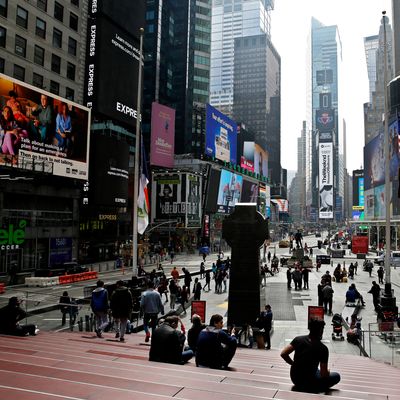
When the theater stopped, it stopped all at once. Live art is all the things the virus loves: close quarters, significant duration, people singing and trumpets going full blast. Broadway closed on March 12, 2020, and by the end of that weekend, every venue in the city was dark.
Reopening, on the other hand, will be a wild hodgepodge. The lights will go on at different times theater by theater, even — in some multi-stage venues — room by room. Governor Cuomo announced last month that regardless of health metrics, live indoor performance will be allowed to return to “flexible” venues at 33 percent capacity starting today, April 2. What, exactly, will that look like?
The embattled governor’s announcement about April 2 will not actually mean most theaters will start producing on that date. To be clear, there will be shows to see: You could go to the first performance of Blindness at the Daryl Roth (there are no performers, just a sterilized headset with the voice of Juliet Stevenson) or the one-man show What the Fuck Just Happened? by Mike Daisey at the tiny Kraine Theater, at which the producers ask that the entire audience be vaccinated. But Broadway won’t be back until the fall — Diana the Musical announced its return on December 1, one of the first Broadway shows to offer a concrete date — and the thick band of non-profit venues that make up most of the city’s serious theatrical output are taking their time as well.
In March, just after the announcement, I visited a recent Zoom with several managing directors from New York’s non-profit theater sector and most sounded doubtful about audiences actually being in their theaters anytime this spring … or even this summer. Tory Bailey, the executive director of the service organization Theater Development Fund (TDF), has been working with the market-research firm WolfBrown, and she has shared the group’s findings with the theaters on the call. WolfBrown is finding that audiences are reluctant, and, for now, they’re not the only ones. Their numbers are similar to those in a small study done by the firm Limelight Insights by Shugoll, whose polling in Washington, D.C., indicates that 52 percent of audiences won’t be “very willing” to return to indoor theaters until December, vaccine or no vaccine.
There’s also the matter of the shows themselves. Realistically, the theaters that will open their doors in April will be the presenting or touring venues — which can welcome installations or musical acts — not those who produce original theatrical works themselves. (This is partly because of institutional structure, partly because of the very different requirements established by the theatrical unions. For instance, the Park Avenue Armory is already set up to bring in pieces that have been made elsewhere, while a producing organization like the Public Theater would have needed to work out with Actors Equity how to get actors into rehearsal, which is still a fraught issue.) On the Zoom, Suzanne Appel from the Vineyard theater points out, “We have an 138-seat theater, and 33 percent is not a whole lot from a financial perspective. I think this is wonderful, but for now we’re staying the course and focusing on some of the outdoor work, using Open Culture [a now-available permit from the city, akin to Open Restaurants, which allows outdoor production] and investing in the renovations of our space.” The Executive Director of Soho Rep, Cynthia Flowers, was crisper: “Anyone with half a brain can see that part of the reason this announcement was made was so that there are not stories that say ‘it’s been a year since the industry shut down, and there’s still no date for reopening.’” Messaging aside, Flowers says the April 2 date is somewhat helpful. “Soho Rep has a really long runway in terms of our production process,” she says, as the other managing directors nod in agreement. “So I look at that, and I say, okay, it seems like we can maybe soon get into a room with people and start developing their work again, even if we’re not sharing that with audiences until the fall or next year.”
Sade Lythcott, the CEO of National Black Theatre, was thrilled there was any kind of onramp in the announcement. “You don’t know how hard we fought for any kind of runway,” she said. Educating government offices about the arts landscape has been one of the key tasks of the shutdown. Other reopening announcements — indoor dining, movie theaters — have usually been made just days before they become effective. So the month between the announcement and April 2 does, at least, demonstrate awareness that live performance won’t toggle on like a light switch. Simply helping politicians understand the necessity of a month’s lead time is part of a long-haul strategy to help New York’s political leaders better grasp the misunderstood sector. Lythcott speaks, for instance, about doing orientations with new City Council members, familiarizing them with the needs and reach of the Coalition of Theaters of Color, a group she chairs.
The messages are getting through: While the arts were barely mentioned in New York politics for the first ten months of the pandemic, now four mayoral candidates evince arts-forward agendas. Maya Wiley talked about implementing New Deal New York, which would actively put artists back to city-subsidized work; Kathryn Garcia released a public-space-focused plan as part of her initiative Reopen to Stay Open; Raymond McGuire’sn19-page Comeback Plan proposes a NYC Comeback Festival to supercharge cultural visibility; and Andrew Yang thinks it might be fun to have cut-price outdoor Broadway productions in the boroughs. (There are, in fact, already Broadway in the Boros and Off Broadway in the Boros programs, beloved projects championed by the Mayor’s Office of Media and Entertainment commissioner, Anne del Castillo.)
Yang is like many folks: He thinks Broadway when he thinks New York theater. But because of the immense costs of Broadway production, the dominance of the many artisan unions and the street’s razor-thin margins, it isn’t actually the flag-bearer of return some want it to be. Touring shows, however, might be. One Broadway source asserted that the shows that get their touring business together first will gain crucial liquidity, which would mean a springboard to Broadway. When a Broadway show announces touring dates, a New York announcement should soon follow. It almost certainly won’t be until the state allows something close to full seating, though. One Broadway veteran crunched the numbers and said, “I’d rather wait it out and come back properly. Large musicals break even at 60 percent of gross potential. And here you’re talking about walking in at 30 percent? You’d be losing hundreds and hundreds of thousands of dollars a week, for what reason?” There are reports that Hamilton might return for a Fourth of July at 25 percent capacity, selling $1,000 tickets, but that show is an outlier in almost every respect — and the Independence Day show sounds more like a stunt than a strategy.
The deepest wounds to New York theater are the absences. Thousands of artists, dramaturgs, administrators, and technicians have left the city, and something will be needed to tempt them back. “If we thought last year was hard, this next year will actually be harder,” says Appel. When it comes to institutional survival, there is much good news. What was once called the Save Our Stages bill is now the Shuttered Venues Operator Grant — $16 billion disbursed by the Small Business Administration’s Office of Disaster Assistance to producers, promoters, live-event venues, and even zoos. (Applications open April 8.) Still, without the bare assistance of rent relief, the situation for many New York artists is untenable. Even for the salaried, the Paycheck Protection Program has sometimes accidentally loosened ties between workers and the field. Before the federal loans came through, some theaters reluctantly furloughed staff, slicing their organizations to the bone. Dismissed workers felt themselves untethered, so some sheltered outside the city and others reevaluated a life in the arts. Then, weeks later in some cases, PPP suddenly came through — for instance, in New York, workers were rapidly de-furloughed at the Public Theater and the Signature Theater. That should have been good news.
But it hasn’t always been. Finding out your theater thinks you are expendable can be a wound that doesn’t heal, especially in an industry that talks about love more than it talks about bonuses. Every person I have spoken with in the past 12 months pointed to the interdependence of the not-for-profit and commercial theater ecosystems, which is now starkly clear. That can lead to certain vulnerabilities: For instance, Broadway opening after the smaller and more flexible shows means a giant hole where the best salaries, design-assistant fees, and contracts used to be. But that new sense of interconnectedness — what the philosopher Jan Patočka called “the solidarity of the shaken” — has also led to a deep strengthening. Commissioner Del Castillo has been encouraged by the way the arts community has taken this time to reexamine itself. “I grew up in New York City, a child in the ’70s,” she says. “I’ve seen the city go through many waves of change, but the creative community has always prevailed in some way.”
So the April 2 date is a mirage; reopening is a long way off. But these conversations — themselves a silver lining — are real and happening now. “The safety net we all thought existed was not there,” says Lythcott. “And so we became for each other a stitch-by-stitch, scrap-by-scrap weaving together of our own safety net.” 2020 was a year of waiting for rescue. But now, says, Lythcott: “We save us.”


